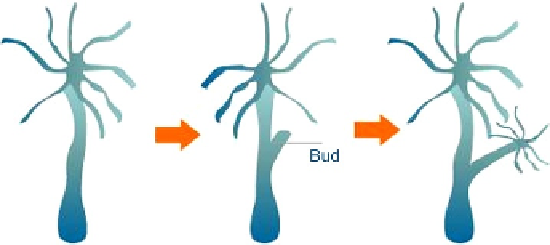Biology Reference
In-Depth Information
Figure 2.23
Budding in
Hydra.
are captured by choanocytes, which transport them to the egg cell. The fertilized egg
produces a larva from which a sponge gradually develops.
Reproduction in Eumetazoans
The transition from unicellularity to multicellularity required new modes of repro-
duction. Sexual reproduction is the most widespread form of reproduction, which is
used by more than 99% of vertebrate species. A relatively small number of species
reproduce by budding, internal budding, and fragmentation. They start from a single
reproductive cell (egg or zygote) that is capable of developing into an organism of
their own kind. Let us start with a glimpse on these “primitive” forms of biological
reproduction.
Some lower invertebrates are reproduced both sexually and asexually. Some
Hydra
species switch from sexual reproduction in summer to asexual reproduction
by external budding in winter (
Figure 2.23
). Budding is the most common form of
asexual reproduction in eumetazoans: the mother produces in its body a group of
specialized cells from which another individual of the same species develops. This
form of reproduction is observed in the females of some cnidarians, tunicates, and
flatworms.
Asexual Reproduction in Eumetazoans
Reproduction by Fragmentation
The fascinating reproduction mode of self-fragmentation is most commonly
observed among flatworms, especially among some free-living freshwater planar-
ians and a number of echinoderms. In an apparently “suicidal” behavior, they con-
strict and divide their body at some point behind the pharynx, after which each part

Search WWH ::

Custom Search